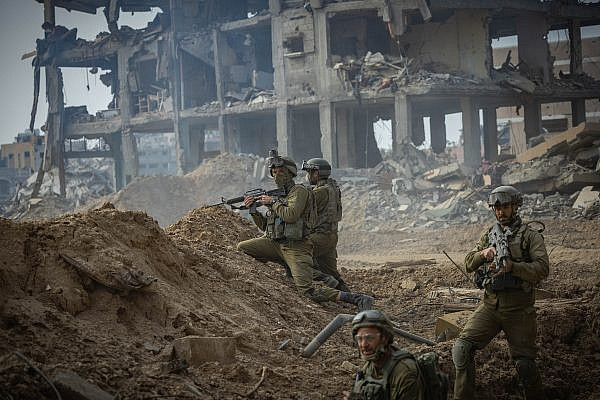The last days have been the hardest we have experienced since the war began, here in the southern Gaza city of Khan Younis. Until last Friday, this area was designated a “safe zone” — a farcical description considering the Israeli army has bombed the city non-stop, but one that nonetheless brought an influx of hundreds of thousands of displaced Palestinians from the northern parts of the Strip, which Israeli troops have directly occupied for more than a month. Now, the army’s invasion of southern Gaza is underway, and residents have nowhere to run.
Early Saturday, Israeli tanks entered the city of Deir al-Balah in the center of Gaza, cutting off Salah al-Din Road — the main highway that runs through the Strip from north to south. Heavy bombardment of parts of Khan Younis soon followed, including the destruction of six residential towers in Hamad Town. As I write this, Israel’s tanks are rolling into the outskirts of the city.
As soon as hostilities resumed on Friday following a seven-day lull, Israeli warplanes dropped leaflets warning residents of the eastern regions of Khan Younis to move to the center. This included thousands of terrified people seeking shelter in hospitals, universities, and schools managed by the government and the UN Relief and Works Agency (UNRWA), after the city’s population had swelled to triple its prewar size.
Soon after, the Israeli army began disseminating an interactive map splitting the entire Gaza Strip into 2,400 numbered segments, and telling residents — most of whom are struggling to even maintain an internet connection — to familiarize themselves with their zone. Then came the next evacuation orders, calling on residents of various areas inside Khan Younis and the surrounding towns of Al-Qarara, Khirbet Al-Adas, Khuza’a, and Abasan to get out.

Some are being instructed to go west, to the coastal area of Al-Mawasi. Others are being pushed further south, toward the Rafah crossing with Egypt. These evacuations appear to be in line with a leaked proposal by Israeli Prime Minister Benjamin Netanyahu to “thin” Gaza’s population, by forcing hundreds of thousands of Palestinians across the border into Egypt and via the sea to Europe and Africa.
In both locations, displaced families — often fleeing for the second or third time since the war began — are being left stranded on the streets due to a lack of shelter, totally exposed to Israel’s ongoing bombardment of all parts of the besieged Strip.
Salim Mallouh, 55, has been living in Al-Qarara for over a month after he and his family were displaced from Gaza City. Now, they are being forced to move all over again. “We came to stay with our relatives, and we thought the war would end and then we would return to our homes,” he explained. “But instead we have experienced the most difficult days due to bombing and artillery shelling.
“We tried to endure these explosions, but the Israeli army ordered us to leave,” he continued. “My family of over 30 people went looking for another shelter, but we found nothing but schools. I will look for a house or a place in Rafah so that we can be safe.

“This war has not had mercy on anyone,” Mallouh added. “It aims to displace us from our homes and kill us in areas that Israel claims are safe.”
As the attacks intensified, thousands of people fled their homes and shelters in Khan Younis and moved south to Rafah in search of shelter — largely to no avail. Many have been forced to remain outside, hungry and thirsty, in the cold and wet weather.
Most read on +972
“Where do I take my children?” Soha Radi, a 32-year-old mother of four from Al-Ma’ani in the north of Khan Younis, asked despairingly. “It is easy for the occupation [forces] to tell us to leave our homes, but we need to be provided with shelter instead of sitting in the street.”
This war, she continued, is making Palestinians “die a thousand times.” “I do not have any relatives in the city of Rafah,” Radi explained. “When my husband went to look for a place, he told me that the schools are full of displaced people and the streets are very crowded. I do not want to leave my home; I want to die in it.”




